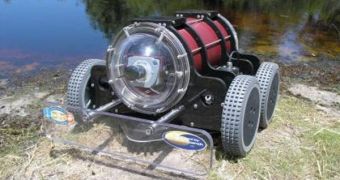As the United States try to reduce their dependency on foreign oil, the Navy is one of the leading actors in this effort. Its ships consume vast amounts of oil each year, and the Office of Naval Research (ONR) is looking at reducing these amounts by as much as possible. Recently, they've created a new, underwater robot, whose purpose is to dive next to the ships' hulls, and clean the biofilms off them as fast and accurately as possible.
The new instrument has multiple benefits, the Office says. For instance, it can perform in environments that would otherwise be difficult to conduct maintenance work in, such as in the middle of the ocean. If ships have it, then that means they will no longer be forced to “park” in dry docks as often as they do today. In addition, they would experience a lot less drag when moving forward through the water, and would also save fuel at the same time. The engines would no longer have to function extra, just to propel the ship over the same distance it would go without biofouling.
“One of the avoidable costs in fuel for the Navy is related to marine fouling such as barnacles that accumulate on ships. They create increased drag as these ships move from port to port across the world's oceans,” Steve McElvany, who is the program officer at the ONR, explains. According to official statistics, marine microorganisms attached to ships reduce their speed by ten percent, on average, and increase fuel consumption by approximately 40 percent. The extra force is needed to defeat the added drag.
“The best way to stop barnacles from colonizing is don't let them settle and colonize on the hull in the first place,” McElvany says. The result of the ONR-funded effort is the Robotic Hull Bio-inspired Underwater Grooming tool or Hull BUG, which relies on modified fluorometer technology to detect the biofilms as it swims near the hull.
If used in combination with other environmentally friendly agents, such as special hull coatings, the new robot could “save millions of dollars per year in fuel. Using less fuel also means less carbon dioxide in the atmosphere. We are really trying to look very far forward to get the ultimate solution,” the expert adds.

 14 DAY TRIAL //
14 DAY TRIAL //